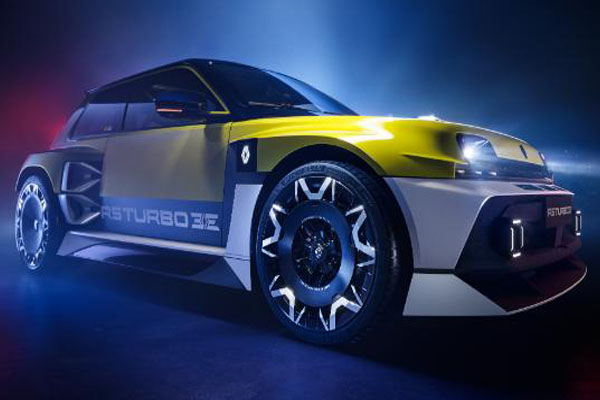12 May 2015
The new electric Renault 5 Turbo 3E was unveiled on the 45th anniversary of the original 5 Turbo, but why is the 80s car such an icon
Renault is fully exploiting the automotive romanticism of the 1980s, reliving old glories by reviving much-loved models such as the Renault 5, Renault 4 and the Twingo. Perhaps the most inspiring model of all is the Renault 5 Turbo – a brute of a hatchback – and it gets the 21st Century treatment with the Turbo 3E, which looks equally stunning.
No stone has been left unturned in terms of the story and PR capital that will be generated by this new model. In line with the anniversary of the 80s legend, 1,980 cars will be built – a nod to the year the original car was launched. Natch.
And customers who want one of these can personalise the livery. This includes the historic colours of Renault 5 Turbo and Turbo 2, such as the Rouge Grenade of production models, or the black, yellow and white racing livery of the Renault 5 Turbo that won the 1982 Tour de Corse rally. Buyers will pay through the nose, however: prices start at £135,000, without the options.
Under the skin though, is where the new car promises real excitement. The Renault 5 Turbo 3E has two in-wheel motors at the rear, making it rear-wheel drive. Developing the equivalent of 540hp, it boasts a massive 4,800Nm of torque and, with its all-carbon superstructure, it weighs under 1,450 kilos aiding the 0-62mph sprint to be achieved in less than 3.5 seconds. It will be the brand’s most powerful road car ever.
The original Renault 5 Turbo – simply the best?
None of this would have happened if it had not been for the original, the Renault 5 Turbo. This is a car that has achieved legendary status, not just because of its performance, its looks or the technology, but the adulation it achieved in motorsport in an era where world rallying, and Group B in particular, was at its most popular.
As a road car, it looked the part. The configuration was laughably simple but effective, particularly for those who wanted a ‘driver’s car’. With a (1400cc) turbocharged rear mid-engine and rear-wheel drive layout, it promised the perfect combination in terms of driveability (and fun): this was no benign, over-engineered experiment.
The Renault 5 Turbo was launched at the Brussels Motor Show in January 1980 as a street-legal vehicle with minimum production numbers to conform to homologation regulations and to give it production car status. Really, it shouldn’t have ever gone near a street, since this was nothing more than a slightly diluted rally car, but the 80s was an era where hedonism, excess, speed and wealth were celebrated, regardless of the outcomes.
Like the Turbo 3E, it didn’t come cheap, but punters were prepared to pay and market demand for the Renault 5 Turbo exceeded the required homologation production minimums, such that a total of 4,987 (1,820 Turbo 1 and 3,167 Turbo 2) R5 Turbos were manufactured during the six-year production run.
Of course, there were plenty of hot hatches to keep boy racers amused during this period: the Fiesta XR2, Golf GTi, Vauxhall Astra, Escort XR3 and Peugeot 205 GTi were all competing in this hallowed space, but all these cars lacked the absolute brutishness of the 5 Turbo.
The verdict: 1980 v 2025?

What’s better, then? Well, it depends how purist you are: petrolheads generally dismiss electric vehicles as homogenised bits of metal that have little soul or driving merit, but… you cannot deny that, as a performance beast, the 3E is in a different league to its forebear. The 1980s version sprinted from 0-60mph in less than 8 seconds and topped about 125mph, which is fundamentally ordinary when you compare it to the electrified version. It’s also fair to say that although the 5 Turbo looked the part, it wasn’t quite as driveable as you might expect. Reports of minor understeer were frequent, but also when pushed, the 5 Turbo was revealed to be tail-happy. That’s fine if you were Jean Ragnotti (who won the Monte Carlo and Corsica rallies), but for the less able, it could become an issue, thus earning its ‘widow maker’ tag. Also, its high-boost engine suffered from heavy turbo lag and there was little punch below 3500rpm. Throttle response was surprisingly slow.

Of course, the 3E is superior in terms of outright performance and its handling capabilities are yet to face the scrutiny of the automotive media, but one suspects that with modern-day technology, the driving experience will fit the bill, even for the EV sceptics.
It is, however, worth sitting on the fence on this one. The 1980s version broke the mould in terms of the look, and it should be revered because of Renault’s uncompromising commitment to building what can only be regarded as a rally car for the ‘street’. That’s probably not going to be the sentiment for the new electric version.

COMMENT